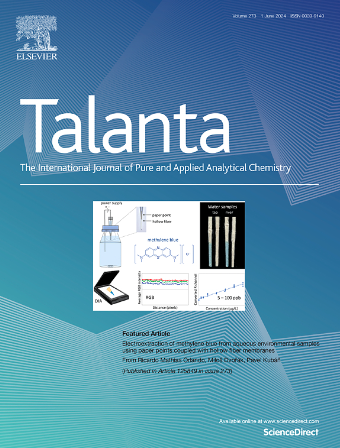Electrophoresis-enhanced paper spray mass spectrometry
IF 5.6
1区 化学
Q1 CHEMISTRY, ANALYTICAL
引用次数: 0
Abstract
The development of ambient ionization methods, such as paper spray (PS), has streamlined the transition from a collection of molecules in a condensed-phase sample to the gas-phase ions represented in a mass spectrum. In many cases, time and resources are saved by omitting chromatography and sample preparation; yet this strategy also eliminates the opportunity to process mixtures in the condensed phase. We here report a PS method that, without additional hardware or expertise, enhances mass spectrometry (MS) analysis of mixtures through electrophoresis. By loading analyte solution onto pre-wetted paper and applying spray potential, analytes were spatiotemporally processed according to their electrophoretic mobility before being subjected to MS. The fundamental and analytical aspects of this electrophoresis-enhanced PS (EePS) were probed with polarity switching, pH changes, complex environmental matrices, and a variety of analytes, including natural products obtained directly from plant material, without chromatography. EePS provides only modest separations but exhibits wide pH tolerance, high compatibility with complex environmental matrices, excellent robustness, superb cost-effectiveness, and is amenable to novel mass analysis strategies using portable mass spectrometers in situ.

求助全文
约1分钟内获得全文
求助全文
来源期刊

Talanta
化学-分析化学
CiteScore
12.30
自引率
4.90%
发文量
861
审稿时长
29 days
期刊介绍:
Talanta provides a forum for the publication of original research papers, short communications, and critical reviews in all branches of pure and applied analytical chemistry. Papers are evaluated based on established guidelines, including the fundamental nature of the study, scientific novelty, substantial improvement or advantage over existing technology or methods, and demonstrated analytical applicability. Original research papers on fundamental studies, and on novel sensor and instrumentation developments, are encouraged. Novel or improved applications in areas such as clinical and biological chemistry, environmental analysis, geochemistry, materials science and engineering, and analytical platforms for omics development are welcome.
Analytical performance of methods should be determined, including interference and matrix effects, and methods should be validated by comparison with a standard method, or analysis of a certified reference material. Simple spiking recoveries may not be sufficient. The developed method should especially comprise information on selectivity, sensitivity, detection limits, accuracy, and reliability. However, applying official validation or robustness studies to a routine method or technique does not necessarily constitute novelty. Proper statistical treatment of the data should be provided. Relevant literature should be cited, including related publications by the authors, and authors should discuss how their proposed methodology compares with previously reported methods.
 求助内容:
求助内容: 应助结果提醒方式:
应助结果提醒方式:


